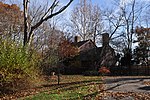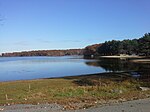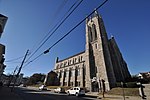Saylesville Meetinghouse

The Saylesville Friends Meetinghouse is an historic Quaker meetinghouse located at 374 Great Road within the village of Saylesville in the town of Lincoln, Rhode Island. The Quaker (Society of Friends) meetinghouse was built in 1703–04, consisting of a modest, nearly rectangular wood-frame structure. An expansion to the building was added c. 1745, joining a larger two-story structure to the old one.Moses Brown and Samuel Slater, credited with founding Slater Mill, often described as the start of the American Industrial Revolution, were members either of Providence Friends Meeting, Saylesville Friends Meeting or Smithfield Friends Meeting House, Parsonage and Cemetery—sources are unclear. Providence Meeting is most likely because of its proximity to Moses Brown's farm, but Slater Mill is also reasonably close to the Saylesville Meetinghouse. Stephen Hopkins, a signer of the Declaration of Independence, was married to Anna Smith in this meetinghouse in 1755. Elizabeth Buffum Chace, member from 1836 to 1841, prominent Quaker abolitionist and possible Underground Railroad station master, lived in nearby Central Falls.
Excerpt from the Wikipedia article Saylesville Meetinghouse (License: CC BY-SA 3.0, Authors, Images).Saylesville Meetinghouse
Great Road,
Geographical coordinates (GPS) Address Website External links Nearby Places Show on map
Geographical coordinates (GPS)
| Latitude | Longitude |
|---|---|
| N 41.900555555556 ° | E -71.418333333333 ° |
Address
Saylesville Meeting House
Great Road 374
02865
Rhode Island, United States
Open on Google Maps









